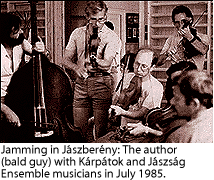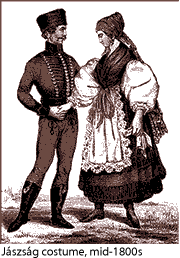| Songs and dances of the Jászság |
| By Mike Gordon The Jászság is a region of Hungary along the Zagyva River, a tributary of the Tisza, in Szolnok county in the northwestern part of the Great Plain (Alföld). Its inhabitants, the Jász people, were a nomadic Indo-European tribe. (Were they originally Iranian? One writer thinks so.) They entered the area in the 13th century as part of the wave of migration that also brought the Kun people into Hungary. Soon afterwards, they came to the military aid of Hungary's King Béla IV, who in turn granted them special privileges which lasted almost uninterrupted until 1876. During the passing centuries, the Jász, like the Kun, were gradually assimilated into the greater Hungarian culture. The Jász were quick to establish market towns in their new territory, which had been devastated by Tartar invasions. After the Turks were forced out of Hungary in the 17th century, the Jász also spread into vacant agricultural lands to the south of their original settlements.
Jászberény, about 40 miles east of Budapest, is the principal town of the Jászság, with a population of 30,000 or more. Legend has it that Jászberény is also the site of the ancient seat of Attila, the famed king of the Huns, and that his coffin made of gold, silver and iron rests on the bed of the Zagyva. Although some of the Jász tribe's ancient words became part of the Hungarian language (for example komondor, sheep dog), the Jász are now considered speakers of the Palóc dialect of Hungarian, and their folklore reflects both Palóc and Alföld influences. Most are Roman Catholic. However, the folklore of the Jászság, like that of Kun lands, long retained Eastern influences -- for example, garments cut along simple, rectangular lines -- that reflected their later arrival from the steppes.
The Kárpátok Ensemble of Los Angeles (including the author, who played kontra. or chord viola, among other instruments) had the opportunity to study the dances, music and songs of the Jászság during an extended visit to Jászberény during the summer of 1985. To the best of our knowledge, Kárpátok is the only performing ensemble outside of Hungary to include the folklore of the Jászság in its repertoire. Kárpátok's artistic director, Tibor Toghia, choreographed a suite of dances from the village of Jászalsoszentgyörgy and also taught the dances of the Jászság to Hungarian dance enthusiasts at a traditional táncház dance party in Los Angeles.
Music of the Jászság Music, lyrics and translations for the songs we collected are available. |
 Traditions of the Jász
Traditions of the Jász From the
Jászság to America
From the
Jászság to America The dance cycle of
the Jászság
The dance cycle of
the Jászság